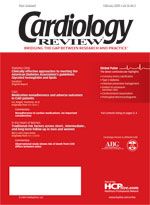Chest pain syndrome in women: A diagnostic dilemma
The ability to diagnose coronary artery disease (CAD) in women may be limited by the sensitivity and specificity of symptoms as well as of noninvasive testing. The choice of which test should be performed to evaluate the presence of CAD in women remains controversial. Currently American Heart Association/American College of Cardiology guidelines recommend initial evaluation with exercise electrocardiogram (ECG) testing. In a meta-analysis of 3721 women, however, exercise ECG had a sensitivity of 61% and a specificity of 70%1 as compared to 68% sensitivity and 77% specificity in men.
Cardiovascular diseases are the leading cause of death in women in the United States, and the obesity epidemic has paralleled this disturbing trend. Atypical symptoms contribute in part to the diagnostic challenge posed when evaluating acute chest pain syndromes in women. For obese women, ischemia workup by such established modalities as echocardiography and radionuclide imaging is limited by poor acoustic windows and attenuation due to body habitus. Cardiovascular magnetic resonance (CMR), with its superior temporal and spatial resolution, obviates these limitations. Cardiovascular magnetic resonance may enhance the diagnostic accuracy of ischemia evaluation in obese female patients.
Presentation and evaluation
A 51-year-old African American female with a history of hypertensive heart disease, non-insulin requiring diabetes mellitus, morbid obesity with hypoventilation syndrome, and mild pulmonary hypertension presented with a recurrent atypical chest pain syndrome. Patient had a previous nondiagnostic stress echocardiogram partly due to poor acoustic windows (
). Evaluation for pulmonary embolism was unremarkable. Initial workup revealed no biochemical evidence of evolving myocardial infarction and no dynamic ST/T changes on electrocardiogram. In view of coronary risk factors, further evaluation with adenosine stress perfusion magnetic resonance imaging (MRI) was pursued.
Diagnosis
Adenosine MRI stress perfusion study demonstrated inducible ischemia in the lateral wall (
) with no evidence of transmural infarction (
). Coronary angiography showed subtotal obstruction of the obtuse marginal branch of the left circumflex artery (
).
Patient management
Successful angioplasty and stenting of culprit lesion was performed.
Outcome
Patient tolerated procedure well, was discharged, and has had no subsequent admissions for chest pain syndrome.
Conclusions
Traditional cardiovascular imaging modalities, such as echocardiography and radionuclide imaging, have diagnostic limitations in a number of patients, including those with lung disease or obesity. Cardiovascular MRI may provide a novel utility in the evaluation of chest pain syndrome in women.
